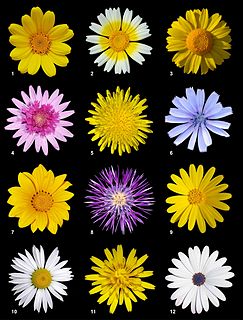
The family Asteraceae, alternatively Compositae, consists of over 32,000 known species of flowering plants in over 1,900 genera within the order Asterales. Commonly referred to as the aster, daisy, composite, or sunflower family, Compositae were first described in 1740. The number of species in Asteraceae is rivaled only by the Orchidaceae, and which is the larger family is unclear as the quantity of extant species in each family is unknown.

Viburnum lentago, the nannyberry, sheepberry, or sweet viburnum, is a species of Viburnum native to North America.

Syngonium is a genus of flowering plants in the family Araceae, native to tropical rain forests in southern Mexico, the West Indies, Central and South America. They are woody vines growing to heights of 10–20 m or more in trees. They have leaves that change shape according to the plant's stage of growth, and adult leaf forms are often much more lobed than the juvenile forms usually seen on small house plants. The scientific name of the genus comes from the Greek words σύν and γονή and refers to the fused ovaries of female flowers.
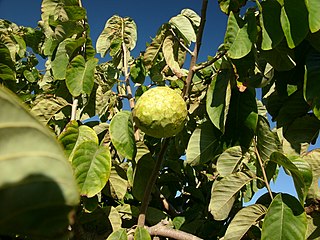
The cherimoya, also spelled chirimoya and called chirimuya by the Inca people, is a species of edible fruit-bearing plant in the genus Annona, from the family Annonaceae, which includes the closely related sweetsop and soursop. The plant has long been believed to be native to Colombia, Ecuador, Peru, Bolivia, and Chile, with cultivation practiced in the Andes and Central America, although a recent hypothesis postulates Central America as the origin instead, because many of the plant's wild relatives occur in this area.

Streptosolen is a monotypic genus of flowering plants in the family Solanaceae. It is closely related to the genus Browallia, within which it was originally placed. The single species, Streptosolen jamesonii, the marmalade bush or fire bush, is an evergreen shrub bearing loose clusters of flowers which change gradually from yellow to red as they develop, resulting in an overall appearance resembling orange marmalade, found in open woodlands in Colombia, Venezuela, Ecuador, and Peru. In its native Ecuador, the plant has the Spanish common names flor de quinde, flor del sol and jaboncillo.

Capsicum pubescens is native to Bolivia, Peru and Ecuador and dates back to pre-Incan times; traces of its presence have been found in the Guitarrero Caves. The existence of Capsicum pubescens was documented by ancient Peruvians of the Paracas, Nazca, Moche, and Chimu cultures, through textiles, ceramics, and domestic remains. This chili pepper is the most important ingredient of the Bolivian sauce llajwa. It is also considered the flagship of Peru and it is consumed fresh, paste, dried, or ground. It belongs to a species of the genus Capsicum (pepper), and is known in Peru and Ecuador as rocoto, locoto in Bolivia and Argentina and as the manzano pepper in Mexico which means 'apple' for its apple-shaped fruit. This species is found primarily in Central and South America, and is known only in cultivation. The species name, pubescens, means hairy, which refers to the hairy leaves of this pepper. The hairiness of the leaves, along with the black seeds, distinguish this species from others. As they reach a relatively advanced age and the roots lignify quickly, sometimes they are called tree chili. Of all the domesticated species of peppers, this is the least widespread and systematically furthest away from all others. It is reproductively isolated from other species of the genus Capsicum. A very notable feature of this species is its ability to withstand cooler temperatures than other cultivated pepper plants, although it cannot withstand frost.

Paulownia tomentosa, common names princess tree, empress tree, or foxglove-tree, is a deciduous tree in the family Paulowniaceae, native to central and western China. It is an extremely fast-growing tree with seeds that disperse readily, and is a persistent exotic introduced species in North America, where it has undergone naturalisation in large areas of the Eastern US. P. tomentosa has also been introduced to Western and Central Europe, and is establishing itself as a naturalised species there as well.

Diospyros virginiana is a persimmon species commonly called the American persimmon, common persimmon, eastern persimmon, simmon, possumwood, possum apples, or sugar plum. It ranges from southern Connecticut to Florida, and west to Texas, Louisiana, Oklahoma, Kansas, and Iowa. The tree grows wild but has been cultivated for its fruit and wood since prehistoric times by Native Americans.
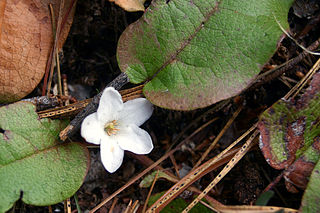
Epigaea is a genus comprising three species of flowering plants in the family Ericaceae. The species are small creeping shrubs that are typically anywhere from 10 to 20 centimetres tall at full growth, forming large patches. The leaves are evergreen, alternate and simple, ranging amongst the three species from 2 to 10 centimetres long. The flowers are small, white or pink, with a five-lobed tubular corolla which is produced in mid-spring. The fruit is a dry capsule with numerous small seeds.

Carissa is a genus of shrubs or small trees native to tropical and subtropical regions of Africa, Australia and Asia. Until recently about 100 species were listed, but most of them have been relegated to the status of synonyms or assigned to other genera, such as Acokanthera.
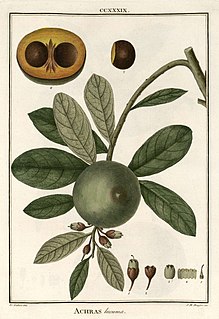
Pouteria lucuma is a species of tree in the family Sapotaceae, cultivated for its fruit, the lúcuma. It is native to the Andean valleys of Bolivia, Chile, Ecuador, and Peru.

Calyceraceae is a plant family in the order Asterales. The natural distribution of the about sixty species belonging to this family is restricted to the southern half of South-America. The species of the family resemble both the family Asteraceae and the Dipsacaceae.

Catalpa bignonioides is a species of Catalpa that is native to the southeastern United States in Alabama, Florida, Georgia, Louisiana, and Mississippi. Common names include southern catalpa, cigartree, and Indian-bean-tree.

Elaeagnus commutata, the silverberry or wolf-willow, is a species of Elaeagnus native to western and boreal North America, from southern Alaska through British Columbia east to Quebec, south to Utah, and across the upper Midwestern United States to South Dakota and western Minnesota. It typically grows on dry to moist sandy and gravel soils in steppes, meadows or woodland edges.
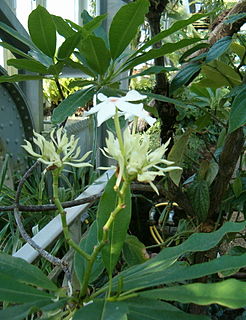
Cerbera manghas, the sea mango, is a small evergreen coastal tree growing up 12 metres (39 ft) tall. The shiny dark-green leaves are in spiral arrangement, ovoid in shape. The flowers are fragrant, possessing a white tubular five-lobed corolla about 3 to 5 centimetres in diameter, with a pink to red throat. They have five stamens and the ovary is positioned above the other flower parts. The fruits are egg-shaped, 5 to 10 centimetres long, and turn bright red at maturity.

Passiflora vitifolia, the perfumed passionflower, is a species of Passiflora, native to southern Central America and northwestern South America.

Guazuma ulmifolia, commonly known as West Indian elm or bay cedar, is a medium-sized tree normally found in pastures and disturbed forests. This flowering plant from the family Malvaceae grows up to 30m in height and 30–40cm in diameter. It is widely found in areas such as the Caribbean, South America, Central America and Mexico serving several uses that vary from its value in carpentry to its utility in medicine.

Fevillea cordifolia, also known as javillo and antidote caccoon, is a climbing vine of up to 20 m of the family Cucurbitaceae and occurring in South and Central America in Bolivia, Brasil, Colombia, Costa Rica, Ecuador, Nicaragua, Panama, Peru and Venezuela.
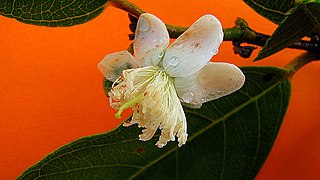
Psidium guineense is a species of guava.

Guthriea capensis is an acaulescent perennial herb endemic to South Africa and occurring in cool and damp sites facing south or east in the mountains of the Cape Province, Lesotho and KwaZulu-Natal. Guthriea is monotypic and was named after the botanist and mathematician Francis Guthrie by his friend the botanist Harry Bolus.




















